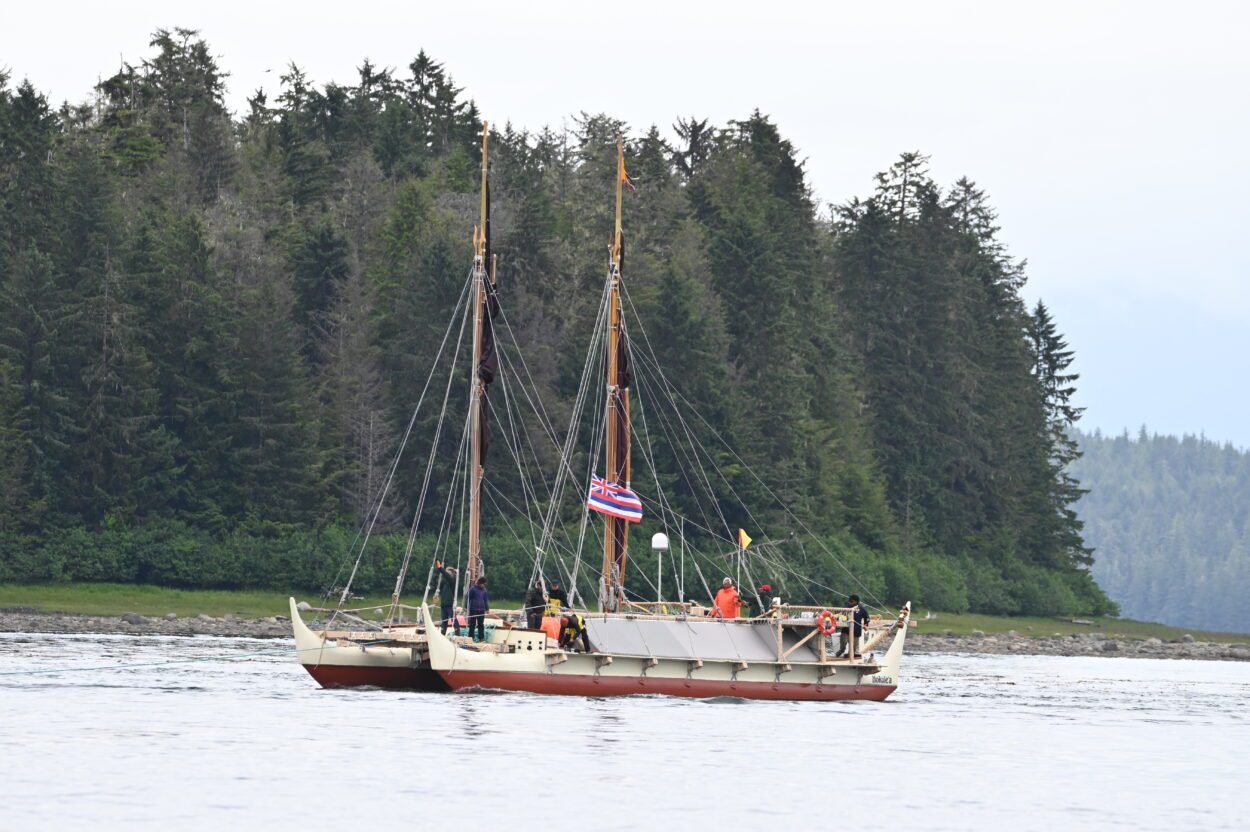
On the last Sunday in June, people flocked to Petersburg’s northernmost point. They were waiting for the first view of the Hōkūle‘a. The twin-hulled voyaging canoe is traversing the waters of Alaska’s Inside Passage during the first month of its four year Moananuiākea voyage. The crew is making the voyage using traditional navigation. During their stay in Petersburg crew members demonstrated navigational techniques and gave tours of the Hōkūle‘a.
Dozens of people crowded the guard rail along Hungry Point. On the beach, a fireman waited to light a stack of gasoline-doused pallets. Those with binoculars trained them in the direction of the Sukoi Islands.
Finally two faint lines of the twin hulls appeared. Excited chatter rippled through the crowd. Drummers, many dressed in regalia, started up a steady beat.
All along North Nordic Drive onlookers waved from windows and doors and lawns. Minutes later, the Hōkūle‘a gently eased into the South Harbor. Tribal members lined the dock, drumming softly as the crew tied up. They began the formal protocol of asking each other who they are and where they’re from.
The next morning, during a taping of KFSK’s show The Common Good, crew member Tua Pittman explained that the greeting protocol is based in their culture of memorizing genealogies.
“You go back through the generations,” said Pittman, “Somewhere along that line of genealogy — the people of the land could connect to a person and say: you’re family. Welcome. And, for me, it’s so fulfilling that we’re still doing that now.”
The Hōkūle‘a was built in 1975. A rotating crew has sailed the vessel around the world several times since. It was built as a way to reclaim the traditional navigation of Hawai’i. But crew member Lucy Lee said it also helped the people of Hawai’i connect with their heritage after decades of cultural repression.
“One of the things that I think was so special about Hōkūle‘a,” said Lee, “Was that she brought Hawaiians forward and gave them something to be proud of again.
One of the tools of traditional navigation is the Hawai’ian star compass. The compass is based on the star positions, with the canoe at its center. They also rely on information from elements — such as the direction and temperature of the wind, the presence of different marine animals, and the direction of ocean swells.
The day after the arrival of the Hōkūle‘a, the crew set up a demonstration of the Hawai’ian star compass at Sandy Beach Park. The compass includes positions of stars and has a model of the canoe in the middle. Captain Mark Ellis is talking Karin McCullough through the process of celestial navigation.
“Now what’s really cool about the North Star is it’s also a latitude marker,” Ellis explained. “So, the further south you go, then North Star actually drops towards the horizon. And that helps you know you’re okay. That helps you know how far north or south of the equator you are.”
Tua Pittman is a navigator on this leg of the journey. He spent years learning the craft. He said that the early morning hours of navigation are the hardest for him. But the difficulty is part of the reward.
“You look across at the star compass on your canoe and you see the sunrise, exactly where it’s supposed to be,” said Pittman. “And that satisfaction of having withstood this whole 24-hour period of staying awake and keeping the canoe on a good course. It becomes very satisfying.”
Mark Ellis has been with the Hōkūle‘a since he was young. He agrees that life on the boat can be both extremely challenging and extremely rewarding.
“I go home and I tell my wife, I’m not gonna go out again on a deep one,” said Ellis. “[So,] remember to tell me that — but my wife always forgets to tell me.”
Ellis said he keeps going out to be part of something bigger than himself. The art of traditional navigation was almost lost, and he said he doesn’t want that to happen again
“I voyage for my grandchildren’s grandchildren,” said Ellis. “I voyage for them, so that they never have to learn about voyaging again, from a book or from a video. I voyage so that navigation never goes extinct.”
Back at Sandy Beach Park it was raining hard, but the crowd was growing. There was a feast of salmon and shrimp and fry bread, herring eggs and potato salad with kelp. Kids from Petersburg’s Native Youth Olympics team demonstrated their abilities. The crew pulled the townsfolk into a circle and invited them to sing Aloha Hawai’i. The song expresses love for Hawai’i and is traditionally sung at gatherings.
The last event of the day is a tour of the canoe. It was still raining, but a long line forms on the floats at the South Harbor. The crew showed visitors where they sleep (in short shifts in the hull of the canoes), explained how they go to the bathroom (harnessed up and hanging over the side) and demonstrated how the vessel is held together (six miles of rope lashing, no bolts). Crew member Rex Lokeni asks to hear each visiting child’s name.
“I am forever grateful that you are bringing your kids with us,” said Lokeni. “So, I’m gonna be upfront, I don’t really care about old people. I care about them. The ones who are coming after us. They will be the architects of our society, and where this world is heading in the near future.”
The next morning, the Hōkūle‘a headed south, bound for Wrangell under sunny skies.











